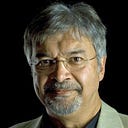Journey to the East (3)
India at last.
In two previous articles I described how in 1969 and the early 1970s, during summer vacation, I made a number of trips by land to South Asia.
In Journey to the East (1) we travelled from Hamburg through Eastern Europe, Turkey and Iran; Journey to the East (2) took us through Afghanistan, ending in Kabul. Today we cross into India.
After spending a week in the wild regions of Afghanistan the contrast is stark. Let me describe it in one little anecdote: after dining in the “restaurants” of Herat and Kabul you pick up certain modes of discourse. In India at breakfast in a nice hotel, one of our group addressed the waiter: “One coffee. Milk no! Sugar no!” — vigorously shaking his head to make himself understood. The waiter bowed stiffly out of his hip and replied in impeccable English: “Certainly, sir: one black coffee coming up.” We were in a different country, with a different cultural background.
Our port of entry to India was Amritsar, where you have to visit the Golden Temple: the Harmandir Sahib (“Abode of God”). Built in the sixteenth century it is the most important spiritual site of Sikhism.
From Amritsar we proceeded to Delhi and Agra, where we visited the scarcely believable Taj Mahal, a white marble mausoleum built by a 17th century emperor for his favourite wife.
The above photo was, once again, taken with our simple camera at the time— you can find many beautiful hires images on the Internet.
We discovered how these are produced: they are laboriously chiselled by young boys.
Next came the Qutb Minar in Delhi. It was built in the 12th century and, at 72 meters, is the tallest brick minaret in the world.
The Qutb has a spiral staircase of 400 steps inside, which we bravely scaled, and were rewarded by a magnificent bird’s-eye view of the temple ruins surrounding the Minar. That included … the “Iron Pillar,” which you can spot on the bottom right of the previous picture. It was built in the fourth century. It is just over seven meters in height and weighs over six tons.
For good luck and fortune you are expected to do what I am doing this picture: wrap your arms backwards around the pillar, with your fingers touching. This of course restricts it to adults — we saw children desperately trying to invoke the magic of the pillar, and not succeeding.
The Qutb Minar with its great height is very impressive. A couple of centuries later a powerful emperor, Alauddin Khalji, decided to build a rival minar twice as high. The project failed and we have just the stump today:
And on it went, on the three thousand kilometer journey southward, using all forms of land transportation. The final destination was Bangalore (that is how it was and still is usually spelled) in the south. After retirement in the late 1950s my German father had bought property in this “garden city,” where the climate was more amenable to his health and well-being. I spent a couple of years in my very early teens in Bangalore, and my mother and brother were still living there. So we were on our way to visit them. But how to get to Bangalore?
The family property had cost Rs 45,000 at the time — with today’s inflated rupees you could just about buy a high-end smart phone for that. It was a beautiful house, a villa really, left over from British times, with a substantial garden, full of trees and interesting plants.
Above you see the Caribbean agave (Agave angustifolia), which develops a ten- to sixteen-foot high flower stalk in late winter through the summer. That’s my mother showing girl-friend Ingrid around the garden.
The final resting place of my father, Alois Friedel. I have told the story of his childhood: he was born in 1888 in Wellheim, a town in the southern German state of Bavaria, and ran away from home at the age of thirteen to become a watchmaker and fine mechanic. He first came to India in 1911, where he spent his free time as a hunter and snake expert. He died in Bangalore in 1964 at the age of 75, leaving behind wife Rose Ursula and his sons Frederic and Alois Jr. Frederic moved to Germany in his late teens, Alois stayed back in India, in the family house. More stories about the adventurous life of Alois Sr. are bound to follow.
